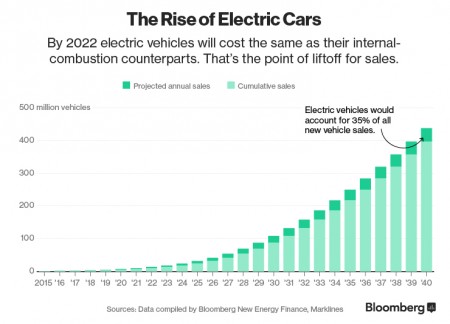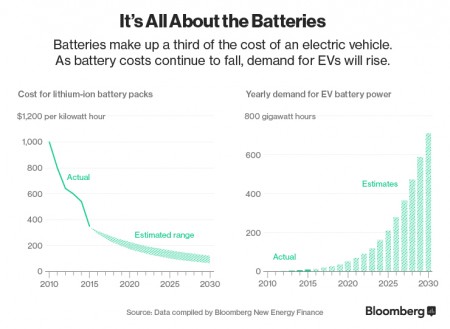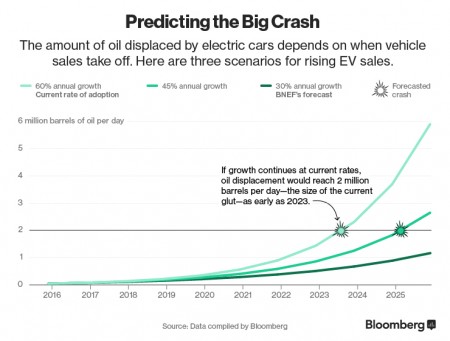February 26, 2016 – In a study published by Bloomberg New Energy Finance yesterday, it forecasts electric vehicles (EVs) will achieve 41 million unit sales by 2040 and 35% of new light duty vehicles. That’s an increase of 9,000% over current unit sales which reached 462,000 in 2015.
The report also predicts that by 2025 EVs will be competitively priced with gasoline and diesel automobiles. Total cost of ownership of EVs will become comparable to internal combustion engines by the mid-2020s even if gasoline-powered vehicles improve mileage efficiency at a rate of 3.5% per year.
What does the Bloomberg report believe will lead to this growth?
- Governments implementing carbon pricing will offer incentives to make EVs cost competitive with carbon-burning vehicles.
- Manufacturers will lower their unit profit margin expectations and seek increases sales of EVs to make up revenue through volume.
- The cost of batteries will drop while battery range and recharge performance will improve.
It is this latter point that is key. The drop in cost of EV batteries from $350 to $120 per kilowatt hour by 2030 will drive adoption by more consumers. There are two types of EVs on the market today: battery driven only vehicles, and plug-in hybrids. Technology leaders include Tesla, Chevy and Nissan. All three along with other manufacturers plan to launch longer-range, mid-priced vehicles within the next year-and-a-half. So what has driven the market up until now, early adopters, people who like to buy new technology, will become displaced by a much larger number of consumers who will buy based on performance and economy.
The early adopters grew EV unit sales in 2015 by 60% even in the face of falling gasoline and diesel pump prices. But as carbon pricing takes hold fossil fuel prices will creep upward while EVs will extend their range on a single charge to approximate internal combustion and diesel vehicles.
Impediments remain. They include:
- The lack of a comprehensive charge station network equivalent to gas and diesel infrastructure in place today.
- The electricity needed to charge EV batteries will have to come from low carbon sources to make a dent in greenhouse gas emissions.
- Batteries will have to continue to get smaller, lighter and cheaper.
- New materials will be needed to replace lithium-based technology which has a number of deficiencies.
One other fly in the oil. If autonomous vehicles catch on and ride-sharing services become the norm, EVs will more than likely experience an enormous surge in sales. The Bloomberg report believes the EV market share by 2040 with adoption of these two disruptive technologies could then reach 50% of new vehicles sold.
What does this mean for oil producers?
For every 1 million EVs sold there is a commensurate drop in demand for gasoline and diesel to fuel carbon-burning vehicles they replace. In the Bloomberg report it paints a number of scenarios. One is built on a continued increase in EV sales at a rate of 60% per year. If this were to happen EVs would displace demand for up to 2 million barrels of oil per day as early as 2023. That 2 million number equals the current glut of oil on world markets triggering the steep decline in oil prices we are witnessing today and the glut of oil on world markets. But analysts believe a growth rate of 60% in EV sales per year is probably unsustainable. In the second scenario they use 45% annual growth in EV unit sales. That puts off the next oil glut crisis to 2028. Now add carbon pricing on a global scale to the mix and all in all the outlook for oil producers will leave them “holding the barrel.”
A final note, nowhere in the Bloomberg report did I see reference to hydrogen-based fuel cell technologies. This may be an oversight since this technology is likely to see growing demand as more manufacturers such as Toyota enter the market and eventually drive down the unit cost to consumers.











